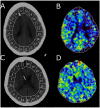Cerebral Blood Flow and Oxygen Delivery in Aneurysmal Subarachnoid Hemorrhage: Relation to Neurointensive Care Targets
- PMID: 35449343
- PMCID: PMC9283361
- DOI: 10.1007/s12028-022-01496-1
Cerebral Blood Flow and Oxygen Delivery in Aneurysmal Subarachnoid Hemorrhage: Relation to Neurointensive Care Targets
Erratum in
-
Correction to: Cerebral Blood Flow and Oxygen Delivery in Aneurysmal Subarachnoid Hemorrhage: Relation to Neurointensive Care Targets.Neurocrit Care. 2022 Aug;37(1):367. doi: 10.1007/s12028-022-01528-w. Neurocrit Care. 2022. PMID: 35606564 Free PMC article. No abstract available.
Abstract
Background: The primary aim was to determine to what extent continuously monitored neurointensive care unit (neuro-ICU) targets predict cerebral blood flow (CBF) and delivery of oxygen (CDO2) after aneurysmal subarachnoid hemorrhage. The secondary aim was to determine whether CBF and CDO2 were associated with clinical outcome.
Methods: In this observational study, patients with aneurysmal subarachnoid hemorrhage treated at the neuro-ICU in Uppsala, Sweden, from 2012 to 2020 with at least one xenon-enhanced computed tomography (Xe-CT) obtained within the first 14 days post ictus were included. CBF was measured with the Xe-CT and CDO2 was calculated based on CBF and arterial oxygen content. Regional cerebral hypoperfusion was defined as CBF < 20 mL/100 g/min, and poor CDO2 was defined as CDO2 < 3.8 mL O2/100 g/min. Neuro-ICU variables including intracranial pressure (ICP), pressure reactivity index, cerebral perfusion pressure (CPP), optimal CPP, and body temperature were assessed in association with the Xe-CT. The acute phase was divided into early phase (day 1-3) and vasospasm phase (day 4-14).
Results: Of 148 patients, 27 had underwent a Xe-CT only in the early phase, 74 only in the vasospasm phase, and 47 patients in both phases. The patients exhibited cerebral hypoperfusion and poor CDO2 for medians of 15% and 30%, respectively, of the cortical brain areas in each patient. In multiple regressions, higher body temperature was associated with higher CBF and CDO2 in the early phase. In a similar regression for the vasospasm phase, younger age and longer pulse transit time (lower peripheral resistance) correlated with higher CBF and CDO2, whereas lower hematocrit only correlated with higher CBF but not with CDO2. ICP, CPP, and pressure reactivity index exhibited no independent association with CBF and CDO2. R2 of these regressions were below 0.3. Lower CBF and CDO2 in the early phase correlated with poor outcome, but this only held true for CDO2 in multiple regressions.
Conclusions: Systemic and cerebral physiological variables exhibited a modest association with CBF and CDO2. Still, cerebral hypoperfusion and low CDO2 were common and low CDO2 was associated with poor outcome. Xe-CT imaging could be useful to help detect secondary brain injury not evident by high ICP and low CPP.
Keywords: Aneurysmal subarachnoid hemorrhage; Cerebral blood flow; Cerebral oxygen delivery (cerebral pressure autoregulation); Clinical outcome; Xenon-enhanced computed tomography.
© 2022. The Author(s).
Conflict of interest statement
The authors have no conflict of interest.
Figures


References
-
- Ryttlefors M, Howells T, Nilsson P, Ronne-Engström E, Enblad P. Secondary insults in subarachnoid hemorrhage: occurrence and impact on outcome and clinical deterioration. Neurosurgery. 2007;61(4):704–14; discussion 14–5. - PubMed
Publication types
MeSH terms
Substances
LinkOut - more resources
Full Text Sources

